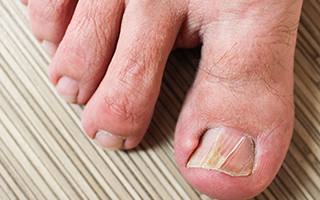
During the warmer months, wearing open-toed shoes causes us to pay more attention to our feet. In winter, we're probably not looking at them as much. But you should take some time to assess your toenails regularly, keeping in mind that the best way to deal with an ingrown toenail is to prevent one in the first place.
Ingrown toenails aren't just painful – they can be dangerous. Any time you break the skin, you open the door to bacteria, which can cause infection. If you have an ingrown toenail and the surrounding area has become red, swollen, hot, and painful, you're likely dealing with infection and need to see a podiatrist.
If an ingrown toenail is just starting to form, however, you may be able to address it yourself. Start by soaking your feet for about 10 minutes in warm water with a tablespoon or two of Epsom salts and/or apple cider vinegar or sea salt. This will help soften the skin and lessen the inflammation. Do this once or twice a day until the area seems accessible. Then use clean nail clippers to clip the toenail straight across. Doing so will help keep the ingrown toenail from recurring. Then apply an antibiotic ointment to keep bacteria out while the skin heals.
Now You Can Give Your Body the Same, Easy Age-Defying Treatment You Give Your Face.
Scientists find that this breakthrough helps your skin look "11 years younger in 4 weeks."
Learn More Now
You can also try an antibacterial, anti-inflammatory product called Domeboro Astringent Solution, which you can find at most drugstores or Amazon. Try soaking your feet for 20-30 minutes a night to calm inflammation and let the nail grow properly.
If you do develop an ingrown toenail that cuts into the skin, coat it with Neosporin or another antibiotic ointment until you can see your podiatrist. Whatever you do, don't try to dig it out yourself. Tweezers, clippers, and nail scissors tossed in your bathroom drawer are going to be covered in bacteria. You run a serious risk of introducing infection and making the problem worse. Let the professional (with clean, sterilized instruments) handle it.
To prevent ingrown toenails in the first place, always cut your nails straight across, not curved. If the corners are too sharp, file them down a bit rather than cutting them. Make sure that you don't cut your nails too short either. When you're standing, the weight of your body creates pressure that forces the skin on the front of your toe up. If you spend a lot of time on your feet, a too-short toenail can cut into that skin as it's growing. So try to keep your nails even with the front of your toes.
Make sure your shoes fit properly too, as friction from improper footwear can make ingrown toenails worse. If you have children, make sure their shoes fit too and that they're caring for their toes. Adolescents in particular often outgrow their shoes rapidly. Since the tendency to develop ingrown toenails can be hereditary, if you suffer from them, you'll want to keep an extra-close watch on your teens.
You may not think that you need to worry about how your toes look in the winter, but if you pay attention to how they feel, you'll be much more likely to have sandal-worthy nails once summer returns.
Better Health and Living for Women,

Janet Zand
Source:
http://health.clevelandclinic.org/2015/03/how-you-can-prevent-and-treat-painful-ingrown-toenails